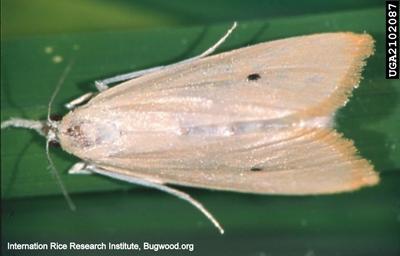Asiatic Rice Borer
Chilo suppressalis
Insect
In a Nutshell
- Seedling die-off.
- Feeding damage on leaf-sheaths, leaves and stems.
- 'Dead heart' in young plants.
- Grains in panicles not filled, 'white head'.
- Moth with yellowish body and forewings, white hindwings.
Can also be found in
Symptoms
In seedlings (often already in nurseries), the attack is characterized by the wilting of young leaves and the dying-off of the growing points, a symptom also known as "dead heart". In mature plants, young larvae make small holes in leaves, especially in the leaf-sheaths. Older larvae drill holes at the base of the internodes, enter the inside of the plant and feed on the soft vascular tissues, sometimes hollowing them out completely. These plants are stunted and show chlorotic leaves that later dry out and curl, eventually falling off. Grains in panicles are not filled, a condition commonly called "white head". One larva can destroy several plants and heavy infestation can bring up to 100% crop losses.
Recommendations

Organic Control
Releasing the parasitoid wasps Paratheresia claripalpis and Eriborus sinicus is an effective way to limit population build-up and damage in some countries. Predators include some species of spiders.

Chemical Control
Always consider an integrated approach with both preventive measures together with biological treatments if available. If insecticides are needed, spray products containing chlorantraniliprole. The application of granules of insecticide at planting and during growth reduces infections. The pest should be diagnosed early in the symptoms, unless it is not worthy to protect the cultivation.
What caused it?
The damage is caused by the Asiatic stem borer, Chilo suppressalis. It is mainly found in south Asia and generally has two generations per year. Caterpillars feed largely on internal tissues, whereas adults are external sap feeders. Beside rice, it can also attack sorghum and some species of wild grasses. Larvae overwinter in stubble and straw and can survive mild frosts. The female lays up to 300 eggs in several batches on the undersides of leaves, usually along the main vein, covering them with a brown secretion. After hatching, the larvae start feeding on the leaf epidermis and later tunnel into the leaf sheaths, thus causing the leaves to yellow, and later, to die off. When they reach the stem, they hollow it out, one internode at a time, penetrating through successive nodes. High silica content in the plant seems to interfere with feeding and boring of the larvae.
Preventive Measures
- Use resistant or tolerant varieties if available in the area.
- Plant varieties with high silica content that impair the feeding and boring of the larvae.
- Avoid planting alternative host plants in the vicinity of the rice field (sorghum).
- Plant early in the season to avoid infestation or use early varieties.
- Monitor the field to detect the symptoms early.
- Flood the fields intermittently to drown the insects.
- Plow after harvest to turn in stubble and straw and to prevent pests in the next growing season.
- Plant in synchronization with the neighboring fields in the area to break life cycle.
- Use pesticides rationally in order to maintain natural enemies.



